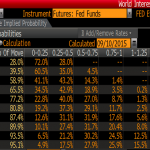Consider the sport of betting on the sport of horse racing. It’s actually similar to the analysis of the gold and silver markets. How’s that?
First, there is the manic-depressive crowd. Sometimes (as we are told—we don’t hang out at race tracks) the bettors sometimes get overly excited about a horse with slim chances to win, or get totally unexcited about a strong horse. The track responds by lowering or raising the payout for winning, respectively. The more betting on a horse, the lower the payout.
The track does not care which horse is likely to win or not win. What it wants to do is take its rake from the total bets placed. It does this by making a spread between what it takes in on all the horses, and what it will have to pay out if any given horse wins. We don’t know the precise formula, but if horse X gets ¼ of the total bets then the payout if X wins had better be less than 4:1.
In keeping with our theme of emphasizing spread rather than price, there is a spread that smart bettors should be paying attention to. A smart horse bettor should have a way of assessing the probability of X winning (and for every other horse in the race). He should bet when the payout is higher than the probability of winning. Suppose in the frenzy of betting on X, almost no one bets on Y. So Y pays 10:1. If a bettor assesses Y’s odds as 5:1, it’s a good bet. Yes, the horse is not probable to win. However, the payout is greater than the odds. Given enough bets with 5:1 odds and 10;1 payouts, a bettor will win in the long run.
We admit to not knowing much about betting at racetracks. There may be lots of reasons why this scheme is not practical (not least of which is being accurate in assessing odds for each horse). That’s not the point, and we certainly don’t recommend anyone to start betting on horse racing.
The point is that the “house” focuses on spread. Sophisticated operators focus on spread. You should focus on spread too.














Leave A Comment